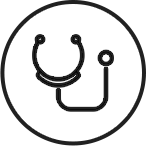General usage and recommendations
- Seed cycling can be done by all individuals who have or have had a period, and who want to assist their natural hormonal cycle.
- Seed cycling can be done by all individuals who have or have had a period, and who want to assist their natural hormonal cycle.
- We recommend taking 2 Two Moons Seed Cycle Capsules per day.
- We recommend taking 2 Two Moons Seed Cycle Capsules per day.
- We recommend taking Two Moons Seed Cycle Capsules after a meal, e.g. either after breakfast or lunch.
- We recommend taking Two Moons Seed Cycle Capsules after a meal, e.g. either after breakfast or lunch.
- Seed cycling may take up to 3 months to start working, however this may vary from individual to individual.
- Seed cycling may take up to 3 months to start working, however this may vary from individual to individual.
- Two Moons Seed Cycle Capsules can be taken for several months until your cycle is regulated, and may be continued as needed for long-term support.
- Two Moons Seed Cycle Capsules can be taken for several months until your cycle is regulated, and may be continued as needed for long-term support.
Special considerations and restrictions
- You should not use Two Moons Seed Cycle Capsules if breastfeeding, pregnant, undergoing hormone therapy, have a diagnosed medical condition, have an allergy to flax seeds, pumpkin seeds, sesame seeds, sunflower seeds, psyllium and chasteberry. If you are taking prescription medications (including dopamine-related medications) consult with a physician before using.
- You should not use Two Moons Seed Cycle Capsules if breastfeeding, pregnant, undergoing hormone therapy, have a diagnosed medical condition, have an allergy to flax seeds, pumpkin seeds, sesame seeds, sunflower seeds, psyllium and chasteberry. If you are taking prescription medications (including dopamine-related medications) consult with a physician before using.
- Yes, Two Moons Seed Cycle Capsules can be taken while practising intermittent fasting or while being on a ketogenic diet.
- Yes, Two Moons Seed Cycle Capsules can be taken while practising intermittent fasting or while being on a ketogenic diet.
- Fibroids can be estrogen-sensitive, and since seed cycling may have phyto-estrogenic effects and chasteberry also influences hormone balance, it is advised to avoid combining seed cycling with chasteberry if you have fibroids.
- Fibroids can be estrogen-sensitive, and since seed cycling may have phyto-estrogenic effects and chasteberry also influences hormone balance, it is advised to avoid combining seed cycling with chasteberry if you have fibroids.
- We generally don’t recommend using Two Moons Seed Cycle Capsules with any hormonal birth control, including the hormonal IUD, as hormonal contraception may disrupt natural menstrual cycles and may interfere with the intended effects of seed cycling and chasteberry.
However, if you have a copper or gold IUD, you may be able to take the Seed Cycle Capsules, as these types of IUDs are non-hormonal and allow for a regular menstrual cycle, maintaining natural hormone rhythms. Although some users with copper or gold IUDs have reported positive experiences with this combination, please note that there are no formal studies confirming these results. As always, consulting with your healthcare provider for personalized advice is recommended.
- We generally don’t recommend using Two Moons Seed Cycle Capsules with any hormonal birth control, including the hormonal IUD, as hormonal contraception may disrupt natural menstrual cycles and may interfere with the intended effects of seed cycling and chasteberry.
However, if you have a copper or gold IUD, you may be able to take the Seed Cycle Capsules, as these types of IUDs are non-hormonal and allow for a regular menstrual cycle, maintaining natural hormone rhythms. Although some users with copper or gold IUDs have reported positive experiences with this combination, please note that there are no formal studies confirming these results. As always, consulting with your healthcare provider for personalized advice is recommended.
- Two Moons Seed Cycle Capsules contain chasteberry (Vitex), which may promote more regular cycles, which could be beneficial on occasion for some individuals with PCOS. However, because PCOS presents uniquely in each person, those with elevated LH levels may experience worsened symptoms with Vitex, as it may exacerbate the LH-FSH imbalance typical in some PCOS cases. While many find Vitex helpful, it’s worth noting that large-scale studies are lacking, and responses can vary widely. To ensure safety and effectiveness, consulting a healthcare provider is recommended before beginning Two Moons Seed Cycle Capsules, particularly if you’re managing PCOS.
- Two Moons Seed Cycle Capsules contain chasteberry (Vitex), which may promote more regular cycles, which could be beneficial on occasion for some individuals with PCOS. However, because PCOS presents uniquely in each person, those with elevated LH levels may experience worsened symptoms with Vitex, as it may exacerbate the LH-FSH imbalance typical in some PCOS cases. While many find Vitex helpful, it’s worth noting that large-scale studies are lacking, and responses can vary widely. To ensure safety and effectiveness, consulting a healthcare provider is recommended before beginning Two Moons Seed Cycle Capsules, particularly if you’re managing PCOS.
- Vitex (chasteberry) may provide relief for some individuals by fostering a more balanced hormonal environment. Since endometriosis is often associated with estrogen dominance, Vitex’s progesterone-supportive properties may be helpful, although it does not directly reduce estrogen levels. Additionally, Vitex’s beneficial effects on PMS symptoms, which often overlap with endometriosis-related discomfort, may make it a complementary option for managing symptoms. Since research is limited and responses vary, it’s best to discuss the use of Vitex with your healthcare provider if you have endometriosis.
- Vitex (chasteberry) may provide relief for some individuals by fostering a more balanced hormonal environment. Since endometriosis is often associated with estrogen dominance, Vitex’s progesterone-supportive properties may be helpful, although it does not directly reduce estrogen levels. Additionally, Vitex’s beneficial effects on PMS symptoms, which often overlap with endometriosis-related discomfort, may make it a complementary option for managing symptoms. Since research is limited and responses vary, it’s best to discuss the use of Vitex with your healthcare provider if you have endometriosis.
- Two Moons Seed Cycle Capsules contain Vitex (chasteberry), which is known for supporting hormonal regulation and may aid fertility by helping to balance the menstrual cycle. However, it’s important to note that Vitex is typically taken throughout the entire cycle to assist with fertility and has shown potential for benefits in the follicular phase as well, as it may support ovulation and then may support luteal phase length, both key to conception. In our product, however, Vitex is included only in the luteal phase, as the capsules are intended for alleviating the symptoms of PMS rather than specifically for cycle regulation for fertility. If you’re trying to conceive, you may want to speak with a healthcare provider who can tailor guidance on Vitex use to your needs and confirm which protocols they recommend to optimize your chances of conception while addressing cycle balance.
- Two Moons Seed Cycle Capsules contain Vitex (chasteberry), which is known for supporting hormonal regulation and may aid fertility by helping to balance the menstrual cycle. However, it’s important to note that Vitex is typically taken throughout the entire cycle to assist with fertility and has shown potential for benefits in the follicular phase as well, as it may support ovulation and then may support luteal phase length, both key to conception. In our product, however, Vitex is included only in the luteal phase, as the capsules are intended for alleviating the symptoms of PMS rather than specifically for cycle regulation for fertility. If you’re trying to conceive, you may want to speak with a healthcare provider who can tailor guidance on Vitex use to your needs and confirm which protocols they recommend to optimize your chances of conception while addressing cycle balance.
- If you are breastfeeding, it’s important to consider the effects of Vitex (chasteberry), one of the primary ingredients in Two Moons Seed Cycle Capsules. Vitex can influence hormone levels by reducing prolactin, a hormone crucial for milk production. While lower doses of Vitex are sometimes used to help balance postpartum hormones, there’s a potential risk that it could impact the milk supply. Because of this, we generally advise against using Two Moons Seed Cycle Capsules while breastfeeding without consulting a healthcare provider.
- If you are breastfeeding, it’s important to consider the effects of Vitex (chasteberry), one of the primary ingredients in Two Moons Seed Cycle Capsules. Vitex can influence hormone levels by reducing prolactin, a hormone crucial for milk production. While lower doses of Vitex are sometimes used to help balance postpartum hormones, there’s a potential risk that it could impact the milk supply. Because of this, we generally advise against using Two Moons Seed Cycle Capsules while breastfeeding without consulting a healthcare provider.
Tailored usage
- Since some women have cycles where the first or second half may be longer or shorter, the timing can be adjusted accordingly:
If your follicular phase (the first half) is longer than 14 days, you take Zest for 14 days and then no capsules until your ovulation. If your follicular phase is shorter than 14 days, you take Zest only until your ovulation, no need to take the rest of the Zest capsules for that month.
If your luteal phase (the second half) is longer than 14 days, you take Zen for 14 days and then no capsules until your period. If your luteal phase is shorter than 14 days, you take Zen only until your period, no need to take the rest of the Zen capsules for that month.
Tracking ovulation can help you determine when to switch phases, and you can use methods like ovulation apps, body temperature tracking, or urine strips.
- Since some women have cycles where the first or second half may be longer or shorter, the timing can be adjusted accordingly:
If your follicular phase (the first half) is longer than 14 days, you take Zest for 14 days and then no capsules until your ovulation. If your follicular phase is shorter than 14 days, you take Zest only until your ovulation, no need to take the rest of the Zest capsules for that month.
If your luteal phase (the second half) is longer than 14 days, you take Zen for 14 days and then no capsules until your period. If your luteal phase is shorter than 14 days, you take Zen only until your period, no need to take the rest of the Zen capsules for that month.
Tracking ovulation can help you determine when to switch phases, and you can use methods like ovulation apps, body temperature tracking, or urine strips.
Product details and quality
- Two Moons Seed Cycle Capsules are vegan and also gluten-free, dairy-free, sugar-free, organic and non-GMO.
- Two Moons Seed Cycle Capsules are vegan and also gluten-free, dairy-free, sugar-free, organic and non-GMO.
- Two Moons Seed Cycle Capsules are made in an FDA and GMP registered facility in the United States with raw material testing, label analysis and final product quality assurance.
- Two Moons Seed Cycle Capsules are made in an FDA and GMP registered facility in the United States with raw material testing, label analysis and final product quality assurance.
Apple Pay Payment Help
- If your Apple Pay payment didn’t go through, don’t worry, it’s usually an easy fix. Here are the most common reasons and what to do:
- Card info changed: If your card was reissued or expired, remove the old one from Apple Wallet and re-add the new card before trying again.
- Bank security block: Some banks flag supplement purchases as higher-risk on the first attempt. Call your bank and ask them to approve the charge.
- Billing mismatch: Make sure the billing address in Apple Wallet matches what your bank has on file precisely, character by character. Even different abbreviations can cause an AVS mismatch ("Street" vs "St."). Check that the zip code is exactly the same, including the number of digits (5 vs. 9).
- Subscription renewal issue: If you’re a subscriber, your payment token may need refreshing. Re-add your card or update payment details from the link in your renewal email.
- Cross-border or currency settings: If your card is issued outside the U.S., ask your bank to authorize international purchases.
Most Apple Pay issues resolve quickly once your card details or bank authorizations are updated.
Tried the above and still need help? Email us at hello@twomoonshealth.co and we’ll get your order sorted.
- If your Apple Pay payment didn’t go through, don’t worry, it’s usually an easy fix. Here are the most common reasons and what to do:
- Card info changed: If your card was reissued or expired, remove the old one from Apple Wallet and re-add the new card before trying again.
- Bank security block: Some banks flag supplement purchases as higher-risk on the first attempt. Call your bank and ask them to approve the charge.
- Billing mismatch: Make sure the billing address in Apple Wallet matches what your bank has on file precisely, character by character. Even different abbreviations can cause an AVS mismatch ("Street" vs "St."). Check that the zip code is exactly the same, including the number of digits (5 vs. 9).
- Subscription renewal issue: If you’re a subscriber, your payment token may need refreshing. Re-add your card or update payment details from the link in your renewal email.
- Cross-border or currency settings: If your card is issued outside the U.S., ask your bank to authorize international purchases.
Most Apple Pay issues resolve quickly once your card details or bank authorizations are updated.
Tried the above and still need help? Email us at hello@twomoonshealth.co and we’ll get your order sorted.
Can I pay with HSA/FSA?
Delivery and availability
- We deliver to all of the states in the USA. After purchase, please allow up to 8 business days for processing, handling and delivery within the continental USA. Please allow extra shipping days for deliveries to Alaska and Hawaii (up to 10 business days). If you have not received your order by then, please contact us at hello@twomoonshealth.co for support.
- We deliver to all of the states in the USA. After purchase, please allow up to 8 business days for processing, handling and delivery within the continental USA. Please allow extra shipping days for deliveries to Alaska and Hawaii (up to 10 business days). If you have not received your order by then, please contact us at hello@twomoonshealth.co for support.
DISCLAIMERS
- Please do not consume if you have a sesame allergy
- As everybody is individual and may have allergic reaction or indigestion from natural products, please stop usage if you notice any adverse symptoms.
**These statements have not been evaluated by the Food and Drug Administration. This product is not intended to diagnose, treat, cure or prevent any disease.
Disclaimer: This is a dietary supplement, best when taken as directed by a qualified healthcare professional. Do not consume if the seal is broken or missing. Not to be used during pregnancy or while nursing. If you are on hormonal therapy, have diagnosed medical conditions, or are taking prescription medications (including dopamine-related medications), consult with a physician before using. Keep out of reach of children and pets. Store in a dry place and refrigerate after opening.
Allergen: Sesame.
DISCLAIMER: these statements have not been evaluated by the Food and Drug Administration.
This product is not intended to diagnose, treat, cure, or prevent any disease.
U.S. patent pending and international patent application pending.














